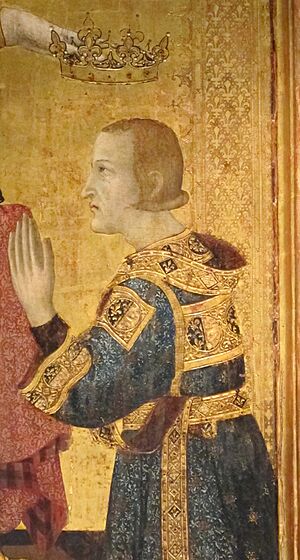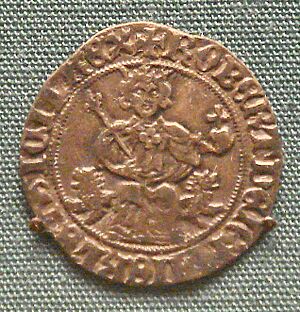Robert, King of Naples facts for kids
Quick facts for kids Robert |
|
|---|---|

Robert in a miniature by Simone Martini, 1317
|
|
| King of Naples Count of Provence and Forcalquier |
|
| Reign | 5 May 1309 – 20 January 1343 |
| Predecessor | Charles II |
| Successor | Joanna I |
| Born | 1276 |
| Died | 20 January 1343 (aged 67) Kingdom of Naples |
| Spouse | Yolanda of Aragon Sancha of Majorca |
| Issue More |
Charles, Duke of Calabria Charles d'Artois |
| House | Anjou-Naples |
| Father | Charles II of Naples |
| Mother | Mary of Hungary |
Robert of Anjou (Italian: Roberto d'Angiò), also known as Robert the Wise (Italian: Roberto il Saggio), was a powerful ruler from 1276 to 1343. He was the King of Naples, a land in southern Italy. He also held the titles of titular King of Jerusalem and Count of Provence and Forcalquier (areas in modern-day France).
Robert was a very important person in Italian politics during his time. He was the third son of King Charles II of Naples and Mary of Hungary. Before becoming king, he was known as the Duke of Calabria.
Contents
Robert's Early Life
Robert was born around 1276. His father, Charles II, was set to become the King of Naples. Robert's grandfather, Charles of Anjou, had founded the kingdom of Naples in 1266.
During a conflict called the Sicilian Vespers, Robert was held hostage by Peter III of Aragon. This was because Peter was an enemy of Robert's grandfather.
In 1285, Robert's grandfather died. This made his father, Charles II, the new King of Naples. At that time, Robert's older brother, Charles Martel of Anjou, was the heir to the throne.
Becoming King of Naples
Robert's older brother, Charles Martel, died in 1295. This meant Robert became the next in line for the crown of Naples. He took over from his young nephew, Charles I of Hungary.
To help secure his claim to the nearby Sicily, Robert married Yolanda. She was the sister of James II of Aragon, the King of Sicily. As part of their agreement, James gave up his claim to Sicily.
However, the local leaders in Sicily did not accept Robert. They chose James's brother, Frederick II, as their king instead. The war continued for a while. In 1302, the Peace of Caltabellotta was signed. This agreement meant that Robert and his family, the Angevin dynasty, lost Sicily forever. Their rule was then limited to the southern part of mainland Italy.
Robert's Rule and Influence
Robert became a strong supporter of the Pope in Italy. The French Pope Clement V, who lived in Robert's region of Provence, supported him. The Pope even made Robert his representative in areas like Romagna and Tuscany.
Robert was a leader of the Guelph party in Italy. The Guelphs supported the Pope, while the Ghibellines supported the Holy Roman Emperor. Robert was against Emperor Henry VII when he came to Italy between 1311 and 1313.
After Henry VII died, Robert's power grew even more. He was already in charge of large areas in Piedmont. In 1313, the Pope named him Senator of Rome, a very important position. He also became the ruler of Genoa (from 1318 to 1334) and Brescia (in 1319). From 1314, he held the title of "imperial vicar of all Italy." This meant he was the Emperor's representative when the Holy Roman Emperor was not in Italy.
In 1328, Robert fought against another emperor, Louis IV of Bavaria, who had come to Italy. In 1330, he made John of Bohemia leave northern Italy. Robert's strong influence in Italy was mainly challenged by the constant threat from Aragonese Sicily.
In 1336, there was a disagreement over who should rule the margraviate of Saluzzo. Robert supported Manfred V against his nephew Thomas II. This was because Thomas had married into the Ghibelline Visconti family. Robert attacked Saluzzo and took control of the city, causing damage and imprisoning Thomas. Thomas had to pay a ransom to be freed.
However, Robert's power in Piedmont began to weaken after his viceroy, Reforza d'Angoult, was defeated in the Battle of Gamenario in 1345. With his second wife, Sancha of Majorca, Robert made the kingdom of Naples a center for early Renaissance culture.
Robert's Death and Succession
Robert died in 1343 at the age of 67. His son, Charles, had died earlier in 1328. So, Robert was succeeded by his 16-year-old granddaughter, Joanna I of Naples.
Joanna was already engaged to her cousin, Andrew of Hungary, who was 15. Andrew was the son of the Angevin king of Hungary, Charles Robert. In his will, Robert clearly stated that Joanna alone should become queen. He said that Andrew should only be the prince of Salerno. Robert wanted Joanna's children to inherit the throne after her. If she died without children, her younger sister Maria would become queen. Robert's will did not mention Andrew being crowned king.
After Andrew's death in 1345, the Hungarian king, Louis I of Hungary, invaded Naples. This event eventually led to the end of Angevin rule in Naples.
Robert's Legacy
King Robert was known as "the peace-maker of Italy." He brought many important changes to Naples. The city's economy was largely managed by merchants from Tuscany. These merchants built beautiful buildings, monuments, and statues. They transformed Naples from a simple port into a city of elegance and medieval beauty.
Robert hired famous artists like Tino di Camaino to create a tomb for his son Charles. The famous painter Giotto also created several works for him. The University of Naples grew and became very important under Robert's support. Students came from all over Italy to study there. The poet Dante once called Robert a re di sermone, which means "king of words," perhaps because of his love for learning and speaking.
Robert often gave speeches and sermons at universities and religious places. This was unusual for a king, as this was usually done by religious leaders. Many records of his speeches still exist today.
Famous writers like Petrarch and Boccaccio remembered Robert as a very educated man. They also saw him as a generous supporter of the arts. Boccaccio said Robert was "unique among the kings of our day," and "a friend of knowledge and virtue." Petrarch even asked Robert to test his knowledge before he was crowned as a poet in Rome in 1341. Petrarch's Latin epic poem Africa was dedicated to King Robert.
Family
Robert had two sons with his first wife, Yolanda, who was the daughter of King Peter III of Aragon:
- Charles (1298–1328): He was the Duke of Calabria and Viceroy of Naples. He was the father of Queen Joanna I.
- Louis (1301–1310)
Robert's second marriage was to Sancia, daughter of King James II of Majorca. They did not have any children together.
Robert also had children outside of marriage:
- Charles d'Artois: He was part of the council that helped Queen Joanna I rule.
- Louis de Bethanie: He was a representative for the court of Louis I of Hungary.
- Maria d'Aquino: She is believed to be the "Fiammetta" in stories by Boccaccio.
- Hélène of Anjou: She married Andrea I Thopia, Count of Matia, without her father's permission. Hélène and Andrea had children together, including Charles, Prince of Albania. Robert did not approve of their marriage.
King Robert's last direct descendant through his official family line was Queen Joanna II of Naples.
Other sources
- Coat of arms of the House of Anjou-Sicily
Sources
|
Robert, King of Naples
Capetian House of Anjou
Cadet branch of the Capetian dynasty
Born: 1276 Died: 20 January 1343 |
||
| Regnal titles | ||
|---|---|---|
| Preceded by Charles II |
King of Naples Count of Provence and Forcalquier 1309–1343 |
Succeeded by Joanna I |


